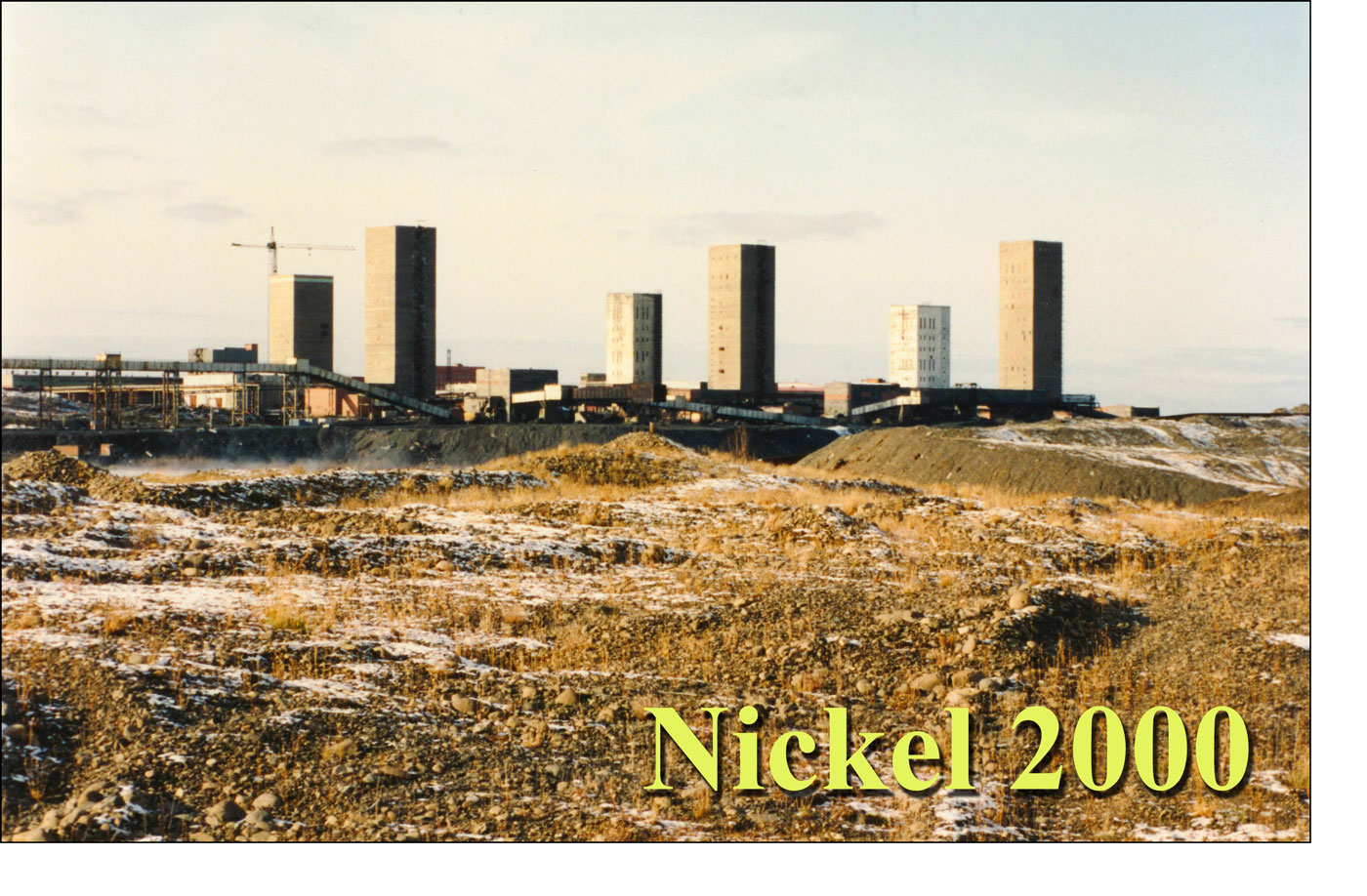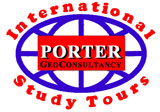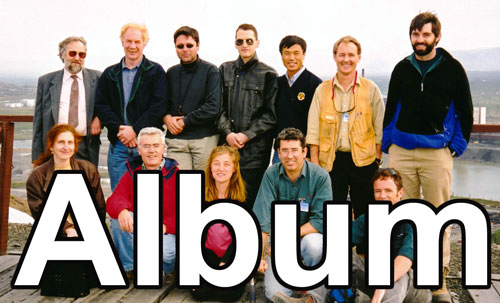
The Australian Mineral Foundation and Porter GeoConsultancy, continued the International Study Tour series of courses by providing a unique opportunity to visit a representative selection of the world's most important nickel resources and mines. Deposits were selected by a 'core group' of senior managers from the World's major nickel producers & explorers.

This tour allowed participants to compare different settings, styles and ages of nickel deposits around the world. It took in a selection of the world's major nickel deposits both primary sulphide and laterite ores. Primary deposits that were visited were in rocks ranging from Archaean to Mesozoic in age, in greenstone belt komatiite flows, to Proterozoic norite-gabbro igneous intrusives to gabbro-dolerite sills/dykes associated with vast basaltic outpourings.

There were also four seminars/workshops, presented by local and internationally known experts. These were designed to provide an overview of the regional tectonic, geological and metallogenic setting of the regions and deposits visited. Field reconnaissances with expert guides were also included.

 - See who went and what they saw - See who went and what they saw
 in the AusIMM Bulletin. in the AusIMM Bulletin. |

The tour involved 3 modules, two of which were divided into 2 parts, as follows:

|
Module 1 - Australasia, Part A - Yilgarn Sulphides & Laterites - 6 days, from Sun 21 to Fri 26 May 2000
|

This module concentrated on Neoarchaean nickel sulphide deposits, both compact massive to semi-massive sulphide and large disseminated deposits, as well as Cretaceous to Cenozoic lateritic accumulations in Western Australia. The program included:

 Perth Seminar/Workshop addressing the "Geological and Tectonic Framework of Western Australia, with Particular Emphasis on the Archaean Nickel Bearing Greenstone Belts"; "The Processes Involved in the Development of Komatiitic Hosted Nickel Sulphide Deposits"; "The Distribution, Styles & Controls of Nickel Mineralisation in the Yilgarn Craton"; "Deep Weathering & the Formation & Classification of Ni Laterite Deposits"; "An Overview of Australian Nickel Laterite Deposits" and "The Regolith Expression of Nickel Sulphide Deposits in the Yilgarn Craton". These topics were adressed by senior expert geologists from the Western Australian Geological Survey (Assistant Director, Tim Griffin), Western Mining Corporation (Mick Elias), the CSIRO (Dr Rob Hill) and CRC-LEME (Dr Charles Butt); This workshop was succeeded on the following days by visits to: Perth Seminar/Workshop addressing the "Geological and Tectonic Framework of Western Australia, with Particular Emphasis on the Archaean Nickel Bearing Greenstone Belts"; "The Processes Involved in the Development of Komatiitic Hosted Nickel Sulphide Deposits"; "The Distribution, Styles & Controls of Nickel Mineralisation in the Yilgarn Craton"; "Deep Weathering & the Formation & Classification of Ni Laterite Deposits"; "An Overview of Australian Nickel Laterite Deposits" and "The Regolith Expression of Nickel Sulphide Deposits in the Yilgarn Craton". These topics were adressed by senior expert geologists from the Western Australian Geological Survey (Assistant Director, Tim Griffin), Western Mining Corporation (Mick Elias), the CSIRO (Dr Rob Hill) and CRC-LEME (Dr Charles Butt); This workshop was succeeded on the following days by visits to:

 Kambalda massive sulphide Ni-Cu which occurs as ribbon like, lens shaped bodies, hosted within a Neoarchaean komatiitic pile in the Yilgarn Craton; Kambalda massive sulphide Ni-Cu which occurs as ribbon like, lens shaped bodies, hosted within a Neoarchaean komatiitic pile in the Yilgarn Craton;

 Silver Swan very high grade Neoarchaean komatiite hosted massive sulphides; Silver Swan very high grade Neoarchaean komatiite hosted massive sulphides;

 Leinster massive and heavily disseminated sulphides, at both the base of a thick Neoarchaean ultramafic complex and thin komatiite units; Leinster massive and heavily disseminated sulphides, at both the base of a thick Neoarchaean ultramafic complex and thin komatiite units;

 Mount Keith large open pit disseminated nickel sulphide deposit in an Archaean greenstone belt of the Yilgarn Craton in Western Australia; Mount Keith large open pit disseminated nickel sulphide deposit in an Archaean greenstone belt of the Yilgarn Craton in Western Australia;

 Murrin Murrin a silicate laterite Ni-Co deposit that overlies serpentinised Archaean, cumulate peridotites of komatiitic origin in the Yilgarn Craton; Murrin Murrin a silicate laterite Ni-Co deposit that overlies serpentinised Archaean, cumulate peridotites of komatiitic origin in the Yilgarn Craton;

 Cawse oxide laterite Ni deposit overlying the Siberia Komatiite in the Kalgoorlie Terrane of the Yilgarn Craton. Cawse oxide laterite Ni deposit overlying the Siberia Komatiite in the Kalgoorlie Terrane of the Yilgarn Craton.


|
Module 1 - Australasia, Part B - South West Pacific Laterites - 6 days, from Sun 28 May to Fri 2 June 2000
|

This module concentrated on both silicate and oxide nickel laterite deposits of post-Eocene age in New Caledonia, and included:

 Noumea Seminar addressing "The tectonic, geologic and structural framework of New Caledonia"; "The distribution, controls and styles of Nickel mineralisation in New Caledonia"; "The nickel industry in New Caledonia"; and "The regulatory regime for exploration and mining in New Caledonia" presented by experts from the New Caledonian Services des Mines et de l'Energie (Director, Laurent Bergeot); the French BGRM (Dr Pierre Maurizot); a local expert geological consultant (Pierre Charlent) a senior geologist from the mining company Société le Nickel (SLN; Bernard Pelletier) and the Université de la Nouvelle-Calédonie (Christian Picard). In particular, these presentations covered both the New Caledonia Silicate Nickel Laterite and Oxide Nickel Laterite mineralisation styles which encompass the deposits that were visited over the subsequent days, as follows: Noumea Seminar addressing "The tectonic, geologic and structural framework of New Caledonia"; "The distribution, controls and styles of Nickel mineralisation in New Caledonia"; "The nickel industry in New Caledonia"; and "The regulatory regime for exploration and mining in New Caledonia" presented by experts from the New Caledonian Services des Mines et de l'Energie (Director, Laurent Bergeot); the French BGRM (Dr Pierre Maurizot); a local expert geological consultant (Pierre Charlent) a senior geologist from the mining company Société le Nickel (SLN; Bernard Pelletier) and the Université de la Nouvelle-Calédonie (Christian Picard). In particular, these presentations covered both the New Caledonia Silicate Nickel Laterite and Oxide Nickel Laterite mineralisation styles which encompass the deposits that were visited over the subsequent days, as follows:

 SLN Thio a large operating silicate laterite mine near Noumea, treating nickel enriched saprolites; SLN Thio a large operating silicate laterite mine near Noumea, treating nickel enriched saprolites;

 Koniambo a silicate laterite nickel resource in the northern half of New Caledonia, being evaluated by Falconbridge & Société Minière du Sud Pacifique; Koniambo a silicate laterite nickel resource in the northern half of New Caledonia, being evaluated by Falconbridge & Société Minière du Sud Pacifique;

 Goro, Prony, Plaine des Lacs District which hosts a number of large oxide laterite deposits then under evaluation in south-eastern New Caledonia; Goro, Prony, Plaine des Lacs District which hosts a number of large oxide laterite deposits then under evaluation in south-eastern New Caledonia;

 SMGM Tomo Mine at Tontouta one of the small mines that produce much of the nickel from the island, commonly as high grade direct shipping ore. SMGM Tomo Mine at Tontouta one of the small mines that produce much of the nickel from the island, commonly as high grade direct shipping ore.


|
Module 2 - The Americas, Part A - Caribbean Laterites - 7 days, from Sun 4 to Sat 10 June, 2000
|

This module concentrated on lateritic nickel deposits on the Caribbean islands of Hispaniola and Cuba, and neighbouring Colombia, and included:

 Santo Domingo Briefing that comprised expert presentations providing "An overview of the Ultramafic Rocks of the Caribbean Region"; "The nickeliferous laterites of the Dominican Republic"; and "The Nickeliferous Laterites of Cuba". These were presented by senior geologists from Falconbridge Dominicana (Julio Espaillat and Jorge Jimenez), and a local consultant geologist (Salvador Brouwer) with experience in Cuba. The latter included expert coverage of the Moa Bay and Nicaro deposits, in particular. This briefing followed the Cerro Matoso visit in Colombia, which had involved an air charter flight out of Bogota to site and return, and was followed by travel to inspect the Falcondo deposit in the Dominican Republic next day. Santo Domingo Briefing that comprised expert presentations providing "An overview of the Ultramafic Rocks of the Caribbean Region"; "The nickeliferous laterites of the Dominican Republic"; and "The Nickeliferous Laterites of Cuba". These were presented by senior geologists from Falconbridge Dominicana (Julio Espaillat and Jorge Jimenez), and a local consultant geologist (Salvador Brouwer) with experience in Cuba. The latter included expert coverage of the Moa Bay and Nicaro deposits, in particular. This briefing followed the Cerro Matoso visit in Colombia, which had involved an air charter flight out of Bogota to site and return, and was followed by travel to inspect the Falcondo deposit in the Dominican Republic next day.

 Cerro Matoso in NW Colombia - an Eocene to Oligocene lateritic deposit developed over a pre-Late Cretaceous lightly serpentinised harzburgite; Cerro Matoso in NW Colombia - an Eocene to Oligocene lateritic deposit developed over a pre-Late Cretaceous lightly serpentinised harzburgite;

 Falcondo an ~15 km string of deposits developed over serpentinised ultramafic rocks, in 4 cycles of weathering and lateritisation since a Miocene uplift. Falcondo an ~15 km string of deposits developed over serpentinised ultramafic rocks, in 4 cycles of weathering and lateritisation since a Miocene uplift.


|
Module 2 - The Americas, Part B - Canadian Sulphides - 7 days, Sun 11 to Sat 17 June, 2000
|

This module concentrated on base metals and gold in the Proterozoic and Archaean Shields of South Australia and Western Australia, and included:

 Sudbury Seminar at Laurentian University, addressing "The geologic setting of nickel deposits in the Canadian Shield"; "An overview of magmatic sulphide deposits"; "The Sudbury Ni-Cu-PGE deposits"; "Sudbury Ni-Cu-PGE metal fractionation"; "What is and is not special about Sudbury"; "The Voiseys Bay Ni-Co deposit"; "The Raglan Ni-Cu-PGE deposits"; "The Thompson Ni-Cu deposits", delivered by renowned experts that included Dr Tony Naldrett, Dr Paul Golightly of INCO, Dr Peter Lightfoot of INCO and Prof. Mike Lesher of Laurentian University. Sudbury Seminar at Laurentian University, addressing "The geologic setting of nickel deposits in the Canadian Shield"; "An overview of magmatic sulphide deposits"; "The Sudbury Ni-Cu-PGE deposits"; "Sudbury Ni-Cu-PGE metal fractionation"; "What is and is not special about Sudbury"; "The Voiseys Bay Ni-Co deposit"; "The Raglan Ni-Cu-PGE deposits"; "The Thompson Ni-Cu deposits", delivered by renowned experts that included Dr Tony Naldrett, Dr Paul Golightly of INCO, Dr Peter Lightfoot of INCO and Prof. Mike Lesher of Laurentian University.

 Voiseys Bay large massive sulphide bodies within a 1334 Ma troctolite sheet in Labrador. Study of drill core and detailed presentation in Sudbury; Voiseys Bay large massive sulphide bodies within a 1334 Ma troctolite sheet in Labrador. Study of drill core and detailed presentation in Sudbury;

 Falconbridge Craig (Onaping) Mine, Sudbury mine visit. A 'contact type' massive sulphide deposit in the Sudbury Igneous Complex noritic Sublayer; Falconbridge Craig (Onaping) Mine, Sudbury mine visit. A 'contact type' massive sulphide deposit in the Sudbury Igneous Complex noritic Sublayer;

 Falconbridge Fraser Copper Mine, Sudbury mine visit. 'Footwall type', Cu rich stockwork ore in the basal Sudbury Breccia of the Sudbury Complex; Falconbridge Fraser Copper Mine, Sudbury mine visit. 'Footwall type', Cu rich stockwork ore in the basal Sudbury Breccia of the Sudbury Complex;

 INCO Totten Mine presentation and core inspection. 'Offset type' mineralisation associated with Offset Dykes of quartz-diorite; INCO Totten Mine presentation and core inspection. 'Offset type' mineralisation associated with Offset Dykes of quartz-diorite;

 Field Traverse to illustrate the key features of both the North and South Range geology and deposits of the Sudbury Igneous Complex; Field Traverse to illustrate the key features of both the North and South Range geology and deposits of the Sudbury Igneous Complex;

 Raglan mine visit, North Quebec. Disseminated to massive sulphides in 1920 Ma dunitic peridotite lenses after komatiitic olivine orthocumulate flows; Raglan mine visit, North Quebec. Disseminated to massive sulphides in 1920 Ma dunitic peridotite lenses after komatiitic olivine orthocumulate flows;


|
Module 3 - Eurasia - Eurasian Sulphides - 10 days, Mon 19 to Wed 28 June 2000
|

This module concentrated on base metals and gold in the Proterozoic and Archaean Shields of South Australia and Western Australia, and included:

 Noril'sk-Talnakh in northern Siberia, Russia Very high grade Komatiite hosted massive sulphides; Noril'sk-Talnakh in northern Siberia, Russia Very high grade Komatiite hosted massive sulphides;

 Jinchuan in China Very high grade Komatiite hosted massive sulphides; Jinchuan in China Very high grade Komatiite hosted massive sulphides;



This study tour was planned, organised and managed by Porter GeoConsultancy as a professional development course on the curriculum of the Australian Mineral Foundation.

|













